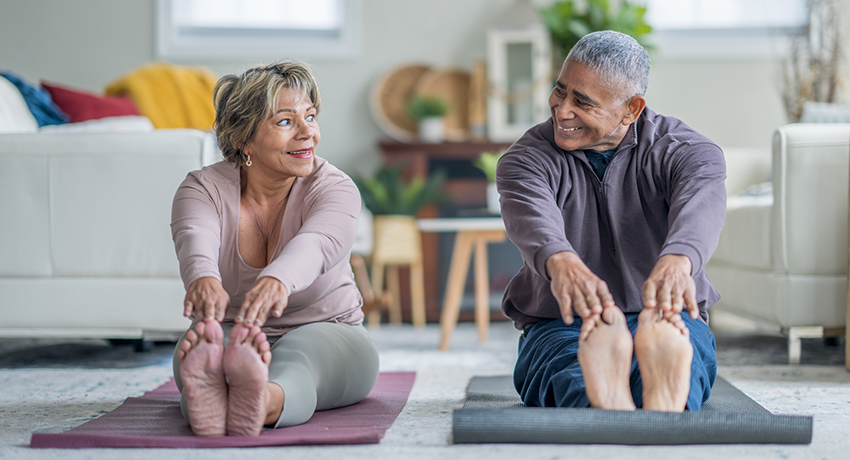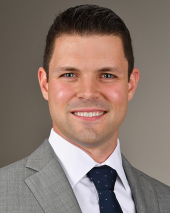Fitness
Exercise Tips for Older Adults With Arthritis | UT Physicians

Staying active becomes increasingly important for overall health and longevity as we age. The benefits are compelling, including improved mobility, mental health, and overall well-being. This can be challenging, however, for older adults with arthritis or joint pain.

Nathan B. Rogers, MD, orthopedic surgeon with UT Physicians Orthopedics – Cypress, said multiple studies have shown that even with arthritic conditions, those who increase lower extremity strength can decrease pain and increase function. Most importantly, it’s never too late to begin.
“Ideally, you should start when you’re younger and maintain health and fitness into your later years,” said Rogers. “However, research has shown there are significant benefits from doing even gentle exercises well into your 70s, 80s, and even 90s.”
Moving despite limited mobility
For those with limited mobility, such as individuals with arthritis, maintaining activity is still crucial, as stiffness can result from both arthritis and inactivity.
“When you add arthritic conditions that tend to make people more sedentary, you have the pain from the arthritis itself and the pain from the weakness,” said Rogers, an assistant professor with McGovern Medical School at UTHealth Houston. “People think, ‘Oh, I have arthritis; I shouldn’t move,’ but it’s the exact opposite. Motion is joint lotion.”
Simple bodyweight exercises and flexibility routines can help keep joints mobile and reduce stiffness. Chair yoga and other seated exercises are excellent options for those with severe mobility restrictions.
One of the biggest challenges in any exercise routine is maintaining motivation. Rogers believes education is key. He spends significant time educating his patients on the benefits of movement, even for those with arthritis.


Exercises for older adults with arthritis
Here are a few exercise options older adults can do at home:
Bodyweight exercises
Rogers strongly believes in the knee conditioning program by the American Academy of Orthopedic Surgeons and shares it with all his patients. These exercises utilize your body weight (except for one) and focus on individual muscle exercises such as quad strengthening, calf strengthening, hamstrings, and more.
“Maintenance of muscle mass correlates to strength and is important in maintaining a functional lifestyle, especially as we age,” Rogers said. “It helps with glucose regulation, diabetes management, and supports cardiovascular health by improving blood pressure and general well-being.”
“Studies have looked at high-intensity and low-intensity exercise regimens with older adults, and it really doesn’t make a difference,” Rogers said. “Any resistance training, whether with weights on the machine or body weight, gives an improvement in symptoms and an improvement in function.”
Balance exercises
Balance exercises are easy to do at home and can help prevent falls and improve stability for older adults.
To work on balance, stand behind a chair and hold onto the back for support. Lift one foot off the ground and hold the position for 10-15 seconds. Switch to the other foot and repeat. Pair this balance exercise as you brush your teeth to ensure it’s part of your daily routine.
Flexibility exercises
Rogers said many of his patients have mild arthritic changes and are stiff. He uses a metaphor of a three- or four-hour car ride and getting out to pump gas. You can get up, but you’re stiff, achy, and have to stretch a bit. He said to imagine doing that for extended periods, which is what you’re doing to your joints when you’re sedentary.
“Taking the joints through a range of motion and working on flexibility is beneficial for all older adults, but more so for those with arthritis,” Rogers said.
Gentle neck, shoulders, back, and legs stretches can help with tight muscles.
Cardio exercises
Cardiovascular exercise and resistance training are both important and go hand in hand, Rogers said. He emphasizes to patients that a truly balanced workout regimen is both resistance training and cardio.
Older adults can make modifications as they focus on cardio health:
- Walk around your home or in place to gain some essential movement.
- Do chair aerobics – sit in a sturdy chair and do arm circles, leg lifts, and marching in place.
- Dance around the living room or kitchen to your favorite music. This can improve your mood and provide an accelerated heart rate at the same time.
“Making exercise part of daily life can go a long way toward your overall health in the future,” Rogers said.

Fitness
How to get your fitness fix without leaving campus

The Recreation and Physical Activity Center, or RPAC, is located at 337 Annie and John Glenn Ave, next to Ohio Stadium. Credit: Samantha Harden | Arts and Life Editor
Among an endless sea of worries for first-year students, concerns about staying active can get lost in the shuffle.
At first glance, it can feel intimidating to walk around campus, searching for the perfect spot to lift weights or go for a run. Fortunately, several on-campus fitness resources can help students stay in shape in almost any way they choose.
Here’s an in-depth look at some of the physical wellness resources Ohio State provides.
Carmen Swain, a clinical associate professor in the College of Education and Human Ecology, said while Ohio State possesses various fitness-oriented facilities, the Recreation and Physical Activity Center — or RPAC — is the main hub.
“We have amazing machine weights,” Swain said. “We also have amazing free weights. You can run the indoor track, you can swim. We have a leisure pool, we have a hot tub, we have a sauna, we have golf simulators.”
Swain said the RPAC also houses many sports courts, from basketball to racquetball to squash.
Though the RPAC is the epicenter of on-campus fitness equipment, Swain said branch gyms have been built across campus to complement its core presence.
Rick Petosa, a professor of kinesiology in the Department of Health Sciences, said these branch gyms — such as the North Recreation Center , Jesse Owens North and Jesse Owens South — have become extremely popular with students despite not being as sprawling as the RPAC. This is because they afford a greater level of privacy, he said.
“RPAC is a very open space,” Petosa said. “And so the weight room, for example, it’s a very large number of square feet, [a] large number of people in there. And some people don’t like to be watched or the fear of being recorded, and so the [branches] of the RPAC are really handy in that regard.”
Swain said another reason students love the branch facilities is simple: convenience.
“People like the satellites because of the ease of access,” Swain said. “I can exercise right when I wake up at a location right by where I live.”
Most of the branch gyms can be found in campus’ North and South areas, but the Adventure Recreation Center — or ARC — is a major facility found in the Western portion of campus, Swain said.
Swain said the ARC provides a somewhat alternative fitness experience, with its turf fields and a rock-climbing wall being among the main offerings.
Aside from gym spaces, Petosa and Swain both said joining a team of time kind, whether at the intramural or club levels, is a great way to establish one’s fitness endeavors at Ohio State.
“Campus Rec offers an extensive range of intramural programs so people can join team sports and other things,” Petosa said. “Football leagues, baseball and just about anything, and so the idea is that exercise for a lot of people is a social activity. Intramural sports offer the opportunity to play with your friends and make new friends.”
Swain also said a wide range of group fitness classes are offered at different facilities across campus on a weekly basis.
“There’s always yoga or pilates — or spinning got really hot for a while — and so they flux depending upon what’s hot right now,” Swain said. “You can just sign up for these classes, and oftentimes they can be free or minimal cost to students.”
Swain said she believes group fitness classes offer students a congenial atmosphere and prime opportunities to make new friends.
“There’s low judgment, anybody can sign up and it’s like, come try a new thing and see if you like it,” Swain said.
Students looking to incorporate fitness directly into their course schedules can do so via the Sport Health and Fitness Program, Petosa said.
“Students can formally enroll, and it covers a whole range of physical activity programs,” Petosa said. “It’s great if someone wants to learn something new about a new sport. If they want to learn about tennis, for example, they’ll get formal [training]. And if they want to learn details about diet and exercise training, they can learn it in those classes as well.”
For students seeking out an easygoing, accessible fitness experience that leads them off-campus, Petosa said the Olentangy River Trail is just the place for them.
“The bike trail goes right along the river, right through campus and then goes right downtown to the bars and goes north of town,” Petosa said.
Overall, Petosa and Swain said Ohio State offers vivid, personalized fitness options for almost every type of Buckeye. They said students should do their best to integrate fitness into their daily lifestyles, especially considering college’s innate stressors.
“We’re looking out for students, and we give students lots of opportunities to be physically active so that it can help promote their physical and mental health so that they have a good time while they’re on campus, but also just helping them to shape their future lives,” Swain said.
For more information regarding fitness on-campus, visit the Office of Student Life’s Recreational Sports website.
This story was updated July 31 at 10:05 p.m. to correct the misspelling of a source’s name in its corresponding print edition, Buckeye Bound 2024.
Fitness
Is it safe to exercise in your third trimester?

There’s no need to stop being physically active when you’re pregnant – and Egyptian fencer Nada Hafez is testament to that.
The sportswoman competed at the Paris Olympics while seven months pregnant with her unborn “little Olympian”, winning her first match in the women’s individual sabre competition, before being knocked out in the last 16.
It was only then that Hafez, 26, publicly revealed she was pregnant, writing in an Instagram post titled ‘7 months pregnant Olympian!’: “What appears to you as two players on the podium, they were actually three! It was me, my competitor, & my yet-to-come to our world, little baby!
“My baby & I had our fair share of challenges, be it both physical & emotional.
The rollercoaster of pregnancy is tough on its own, but having to fight to keep the balance of life & sports was nothing short of strenuous, however worth it.
“Three times *Olympian* but this time carrying a little Olympian one!”
For many mothers, simply carrying a baby in the third trimester is hard enough, without competing in the Olympics at the same time. But keeping physically active is a great way to help mums-to-be stay healthy throughout their pregnancy – although some may feel competing in the Olympics at seven months pregnant is taking exercise to the extreme.
Michelle Baynham, founder of Mother Fit, a pre- and postnatal wellness platform, praised Hafez for competing in the Olympics while pregnant, stressing that as long as the fencer has a healthy pregnancy, it’s safe for her to continue training throughout all trimesters.
“The UK physical activity guidelines recommend pregnant women aim for at least 150 minutes of moderate-intensity activity each week, including muscle-strengthening activities twice a week,” she says.
“All activity counts, but start gradually if you’re not currently active, and keep going if you’re already active.”
Although most women will have an obvious bump by the third trimester, that doesn’t necessarily mean physical activity will be out of the question, explains Baynham.
“It may not feel uncomfortable for her to exercise in the third trimester – every woman’s journey is different,” she says, pointing out that the NHS advises against exercises that risk the woman’s bump being hit, such as martial arts, football, rugby, tennis, or squash.
Far from harming pregnant women’s unborn babies, Baynham points out that exercise during pregnancy has numerous health benefits, such as preventing diabetes, reducing high blood pressure, improving sleep, mood and fitness, and helping control weight gain.
“There is no evidence of harm to the expectant mother or her baby,” she stresses.
However, she points out that Hafez is an elite athlete with a high fitness level and will be acutely aware of her physical limits. “This is not the level most pregnant women should train at unless they too are athletes,” she adds.
Amina Hatia, midwifery manager at Tommy’s, the pregnancy research and baby loss charity, confirms that for most women, it’s safe and beneficial to stay as active as possible throughout pregnancy.
“If you feel well and comfortable, you can keep exercising right up until you give birth,” she says, pointing out that low-impact activities such as walking and swimming are generally good options for everyone in their third trimester, but pregnant women should avoid sports that have a higher risk of serious injury through falling, such as skiing or horse riding, or where there’s heavy physical contact, such as rugby or hockey.
“After 16 weeks of pregnancy, you should also avoid any exercise that involves lying on your back for any length of time, as this can put pressure on major blood vessels and decrease blood flow to your baby,” she says.
Pregnant women with certain health conditions, including heart or lung disease, epilepsy or anaemia, or who’ve previously had more than three miscarriages in a row, should talk to their GP or midwife about how active they can be during pregnancy, warns Haita.
“And you should stop exercising and ask for advice if you have any vaginal bleeding or pain,” she stresses.
“Research has shown that exercise alone doesn’t cause preterm birth, but you should talk to your doctor or midwife if you’ve had a previous premature birth or late miscarriage, or you’ve been told you’re at higher risk of premature labour. There is a chance that exercise could worsen an existing problem, such as a weak cervix.”
Fitness
Six in 10 U.S. Adults Say They Walk for Leisure, Exercise

WEDNESDAY, July 31, 2024 (HealthDay News) — Almost 60% of adult Americans said they took a walk over the past week for leisure, and maybe even some healthy exercise, a new federal tally finds.
Data from the 2022 National Health Interview Survey, a representative sampling of U.S. households, found that last year “58.7% of adults walked for leisure in the past 7 days,” although just who was walking and who stayed on the couch varied.
Gender made a difference: While 60.5% of women said they walked for leisure, that was true for 56.9% of men.
Younger Americans were more likely to perambulate for pleasure than older generations.
“The percentage of adults who walked for leisure decreased with increasing age, from 61.8% of adults ages 18-44 and 59.1% of adults ages 45-64 to 51.6% of adults age 65 and older,” say a team led by Dzifa Adjaye-Gbewonyo of the CDC National Center for Health Statistics.
Income seemed to matter: As incomes rose, the percentage of people who said they regularly walked for leisure climbed as well. For example, while more than two-thirds of people (67.2%) in the wealthiest tier did so, that fell to less than half (46.9%) for adults with family incomes below the federal poverty level, the report found.
Similar trends were seen with education, with the more highly educated walking for pleasure and exercise more often than less-educated adults.
By race, Asian Americans walked the most (63.8%), followed by whites (61.5%), Hispanics (53.5%) and Black Americans (49.2%), the survey found.
Of course, millions of Americans find themselves walking simply to get from point A to point B. The NCHS report found 16.2% of adults saying they walked “for transportation,” and unlike leisure walking, rates of transportation walking tended to rise as incomes fell.
“For many people, walking is considered a relatively easy and accessible physical activity for achieving health benefits,” the report’s authors wrote.
The American Heart Association agrees, noting on its website: “The simplest way to get moving and improve your health is to start walking. It’s free, easy and can be done just about anywhere, even in place.”
The AHA adds that “any amount of movement is better than none. And you can break it up into short bouts of activity throughout the day. Taking a brisk walk for five or ten minutes a few times a day will add up.”
More information
Find out more about walking’s health benefits at the Mayo Clinic.
SOURCES: NCHS Data Brief, July 31, 2024; American Heart Association
-

 Mississippi2 days ago
Mississippi2 days agoMSU, Mississippi Academy of Sciences host summer symposium, USDA’s Tucker honored with Presidential Award
-

 News1 week ago
News1 week agoHow the Trump Rally Gunman Had an Edge Over the Countersnipers
-

 Politics1 week ago
Politics1 week agoTop five moments from Secret Service director's hours-long grilling after Trump assassination attempt
-

 News1 week ago
News1 week agoGeorge Clooney Endorses Kamala Harris, Says Biden Is ‘Saving Democracy’
-

 News1 week ago
News1 week agoVideo: Secret Service Director Faces Bipartisan Calls to Resign
-

 World1 week ago
World1 week agoTyphoon Gaemi barrels towards China’s Fujian after sinking ship off Taiwan
-

 World1 week ago
World1 week agoViolence against women, girls at ‘epidemic’ levels: UK police
-

 Fitness1 week ago
Fitness1 week agoExercising requires budgeting time and money so you reach your fitness goals














